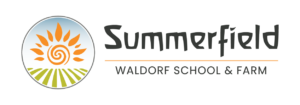Lower School Curriculum By Grade
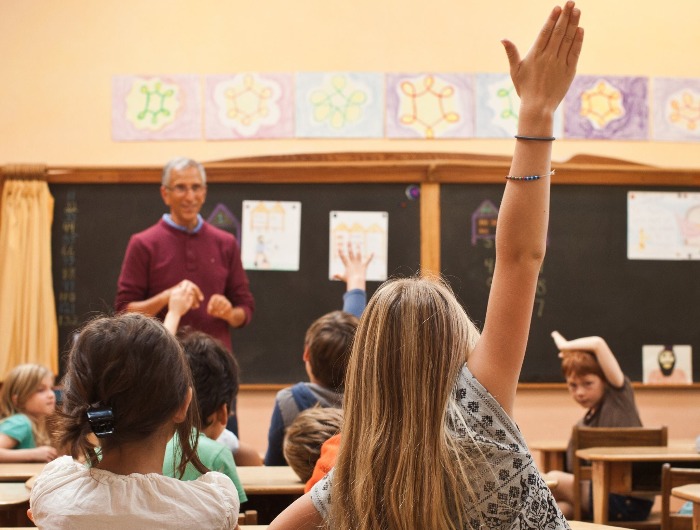
Curriculum
There are many elements in the Waldorf education curriculum — all designed with a multi-sensory approach in mind and a goal to meet the child where they are developmentally in every stage.
MAIN LESSON: The Main Lesson is a block learning format where students focus on one academic subject for around two hours in the beginning of their day. Teachers engage students in these two hours using lecture, movement, art, music, recitation, lab work and more to make learning academic subjects relevant and engaging.
Topics covered in Main Lesson include, but are not limited to:
- Writing
- Reading
- Arithmetic
- Form Drawing
- History
- Social Studies
- Science
Special Subjects and Topics taught include:
- Foreign Language (Spanish, German)
- Farming
- Eurythmy
- Physical Education
- Handwork
- Drawing
- Painting
- Music
Refer to the tabs below to learn how each of the subjects is brought throughout our curriculum in for each grade.
1st Grade
FORM DRAWING: This discipline helps form an inner foundation for geometry, one’s relationship to space, as well as the writing of letters and numbers. Forms are walked, run, drawn in the air and on paper. Symmetry exercises are also done to strengthen the child’s relationship to left and right.
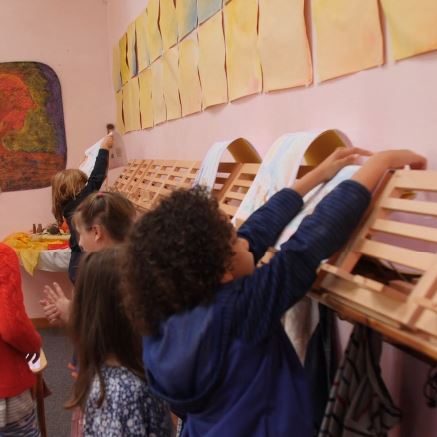
DRAWING: Weekly drawing lessons use images from the fairy tales to teach techniques for drawing basic shapes such as people, houses, trees, etc., using block crayons to draw from out of the color. Lines become color limits, and the blending of colors is a major theme.
PAINTING: The class works mainly with primary colors, experiencing the living quality of each color and its relationship to the others.
WRITING/READING: Children are introduced to the letters of the alphabet through imaginative stories, which lead to the drawing of letters, then writing of words and sentences, and lastly the recognition of what the child has written. Consonants, which give form and shape to the words, are developed out of pictorial forms, such as “M” for MOUNTAIN. The vowels, on the other hand, have a more musical, inner soul quality, for example: “A” (AH) expresses wonder. After the letters are learned, word families such as “ING” or “AKE” are introduced. Sentences are also written and read.
SPEECH: The children recite many poems, verses, nursery rhymes, and speech exercises by heart, using gesture. These are recited chorally with emphasis on rhythm, the expression of feeling, and clear articulation. Fairy tales are told by the teacher and recalled by individual students on the following day. Dramatization and reenacting of the stories by the children is also important.
MUSIC: Daily children sing in the pentatonic mood of the fifth and play pentatonic flutes.
ARITHMETIC: Math begins by introducing the quality of each number up to twelve and then introducing the quantitative aspect through counting to 1,000. The aim is to always work from the whole to the part. Students begin with the sum in addition and the product in multiplication, etc. First graders learn all four arithmetic processes and their interconnectedness. The child is led into counting through rhythmic movement, running, clapping, stamping, etc.
The class uses manipulatives, such as bean bags, fingers and toes, and counting stones, to solve problems using the four processes. Then they are led from the tangible to the realm of pure number in mental arithmetic as a preparation for sense-free thinking. They also work individually, solving problems on paper, and begin a regular practice of many of the times tables.
HANDWORK: The first grade begins the year by creating their own knitting needles through sanding, waxing and polishing. Students learn how to knit and are introduced to the basic skills of casting on and off. They knit squares and learn to shape them into animals by sewing, stuffing, adding tails, ears, etc. Their creativity and powers of decision are being developed for more complicated tasks in later years.
MAIN LESSON BLOCKS IN THE 1ST GRADE: Fairy Tales, Folk Tales and Nature Stories, Pictorial Introduction to the Letters; Preparation for Reading through Writing; Qualities of Numbers; Introduction of the Four Operations in Arithmetic.
Special Subjects:
Foreign Language: Songs, Finger Games, Fairy Tales
Painting: Primary Colors
Farming: Gardens, Exploration and Wonder
Handwork: Knitting
Skills Practice
Eurythmy
Games
2nd Grade
The second grade children are characterized by an increasing liveliness, and are constantly moving. They can seem to live in extremes: one moment joyfully engaged in an activity, and the next moment a social disruption may turn everything upside down. They become increasingly opinionated, have intense feelings and reactions. The teaching must therefore become more intense, with heightened movements for morning circle such as stamping, marching and galloping; recognizing number patterns through changing rhythms, and engaging the wills of the children with all their youthful energy to put themselves into their limbs and their senses. We stimulate the whole organism, rather than just the head, to forge a deeper connection with the material and long term memory.
-Torin Finser, School as a Journey
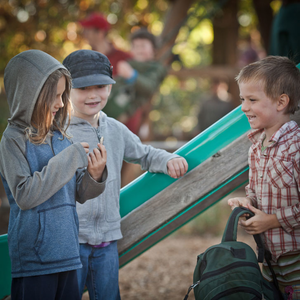 FORM DRAWING: The running, straight and curved line forms become the foundations for cursive writing. The class works with exercises involving left/right symmetry.
FORM DRAWING: The running, straight and curved line forms become the foundations for cursive writing. The class works with exercises involving left/right symmetry.
DRAWING: The class works with familiar themes such as houses, people and trees, but with an emphasis on drawing animals. The students begin to creatively add their own elements to their compositions.
PAINTING: The class continues to work mainly with pure colors, experiencing the living quality of each color and the colors’ relationships to one another. A color study of the complementary colors is done.
WRITING/READING: The year begins with continuing work with lower case letters. Cursive letters are then introduced as letters that “like to hold hands” – the cursive style helps the child to see the whole word rather than focus on the individual letters. The class uses the cursive style for handwriting by copying sentences from the stories into their main lesson books.
After the activity of writing, the sentences are read and used for spelling exercises. Dictations are also given for spelling work. There is continued work with word families, consonant blends and vowel sounds. Grammar is introduced in an elementary way through the parts of speech – the doing, naming, and describing words. This gives the children a foundation from which they are able to create their own sentences.
SPEECH: The children recite poetry and verses that they learn by heart, using gesture and variation in the speed and quality of tone. They also recite tongue twisters. This all has a strong relationship to teaching the child to breathe rightly. Legends of the Saints, the animal fables, and such stories as “The King of Ireland’s Son” are told by the teacher with care towards the beauty and flow of language, and are subsequently re-told by the children on the following day. A class play is presented.
ARITHMETIC: The class works intensively on the times tables (1-12) through rhythmic stepping and clapping exercises and with mental and written problems. Mental arithmetic is done each day during these blocks through a “number imagination”, which quickly moves away from the picture to the realm of pure number. Square numbers, odd and even numbers, and place value to one million are worked with. The processes of addition, subtraction, multiplication and division are expanded upon.
GAMES: The emphasis is on the human voice to initiate movement; for example, one side becomes the sheep and speaks a verse that calls the fox to chase. Students also jump rope, play follow-the-leader, run in geometric patterns, and learn several hand-clapping and string games.
MODELING: The children model with beeswax and clay simple forms that come out of stories that they have been told.
HANDWORK: In second grade, the fundamental knitting skills are reinforced. Following a somewhat rigid pattern of bands, they learn the purl stitch, along with learning to knit and purl in patterned sequence, changing colors, casting on and off, and identifying mistakes and correcting them. Their thinking and awareness are awakened with the changing requirements of this project. Their second project is knitting a doll. With this project, they bring more of their individuality into designing how they want their doll to look, reinforcing the skills of focusing, planning and producing.
MAIN LESSON BLOCKS IN THE 2ND GRADE: Legends and Fables, Stories of Saints and Heroes; Continued work with Writing, Reading and Arithmetic; Cursive Writing introduced.
Special Subjects:
Foreign Language: Poems, Songs, Fables, Group Games
Painting: Complimentary Colors
Handwork: Crocheting, Knitting
Farming: Wood Sawing, Apple Pressing and Drying, Garden Work
Music: Singing, Pentatonic Flute
Modeling: Beeswax
Eurythmy
Games
3rd Grade
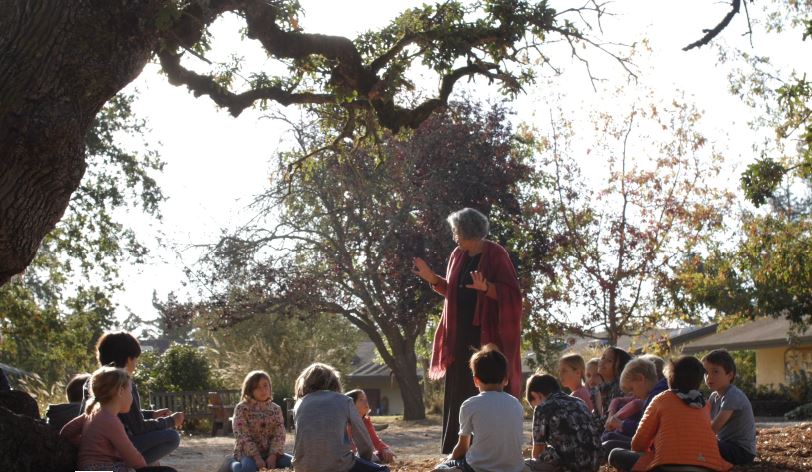 “During the ninth year, the child takes a deep breath and draws itself out of the world in which they were united and goes into an inner soul space within the physical body. The world becomes an object, as the sense of Self grows stronger. The age of the dream is passing, and a new age that will one day culminate in the attainment of full waking consciousness begins to dawn. The Third Grade curriculum has a more realistic, practical quality than the first two grades.”
“During the ninth year, the child takes a deep breath and draws itself out of the world in which they were united and goes into an inner soul space within the physical body. The world becomes an object, as the sense of Self grows stronger. The age of the dream is passing, and a new age that will one day culminate in the attainment of full waking consciousness begins to dawn. The Third Grade curriculum has a more realistic, practical quality than the first two grades.”— Rudolf Steiner
HEBREW LEGENDS: The literary theme of the Third Grade is the Old Testament. These stories are an introduction to the history of the Hebrew people and also a picture of the human beings awakening.
HOUSE-BUILDING: The children learn that the human body is our very first home. They experience how human beings construct houses out of materials they find in the area in which they live. The class studies houses from around the world.
FARMING: The class learns that the earth is a living, breathing being. Weekly, they attend Farm class.
LANGUAGE ARTS: The class copies paragraphs from the board that they use for reading, spelling and grammar study. Much more work is done taking dictations or creating their own compositions for their Main Lesson books. Daily work is done in speech formation through speech exercises, verses and poems. Spelling words are given weekly. The writing of business letters is introduced.
GRAMMAR: An introduction to the parts of speech – noun, verb, adjective and adverb – is given, along with the study of punctuation. The children also learn to diagram sentences.
READING: The children are encouraged to read at home every day, in addition to reading in school during main lesson and reading periods.
ARITHMETIC: Work with the four operations continues, and mental arithmetic takes on a more practical tone. The main theme of the year is linear measurement. Time, liquid and dry measure, and money are also studied.
PRACTICAL ACTIVITIES: The children learn to cook and bake, activities which appeal to the warm feeling life at this age, and simple projects of weaving, dyeing carding, and spinning wool are led.
PAINTING AND DRAWING: Basic color exercises are continued in painting, and some first attempts at allowing the form to arise out of the color are begun. Drawing with block crayons continues, with more complicated themes.
MODELING: The class works with beeswax modeling figures connected to the main lesson work and the seasons.
HANDWORK: The third grade children are introduced to the crochet hook and they learn to create many practical items. Their main project is to create a hat for themselves. Knowing how to create the form without a pattern develops a sense of confidence in the material world. The Third Grade is also introduced to the practical arts of spinning and dyeing.
MAIN LESSON BLOCKS IN THE 3RD GRADE: Old Testament Stories as beginning history; Composition and Grammar; study of Practical Life (farming, housing and clothing); Long Division, Time, Weights, Measures and Money in Arithmetic.
Special Subjects:
Practical Activities: Baking, Cooking, Building, etc.
Farming: Field Harvest, Cover Crops, Field Planting
Circus: Tumbling, Unicycle
Painting: Colors, Forms
Foreign Language: Rhymes, 3-Part Songs, Games, Basic Writing, Telling Time
Handwork: Fiber Arts, Spinning, Weaving, Dyeing, Knitting
Music: Singing, Diatonic Flute, Violin
Reading
Games
Eurythmy
Skills Practice
4th Grade
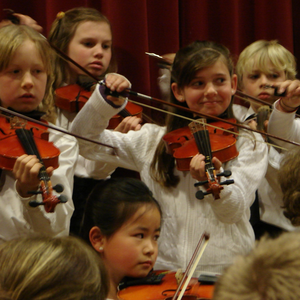 “For the Fourth Grade child, the inner and outer worlds are no longer one. The child experiences these worlds as torn apart. Self-consciousness becomes stronger, and the soul life becomes more inward and independent. The task of the teacher and parent is to lead the child into a world that is filled with beauty and meaning.”
“For the Fourth Grade child, the inner and outer worlds are no longer one. The child experiences these worlds as torn apart. Self-consciousness becomes stronger, and the soul life becomes more inward and independent. The task of the teacher and parent is to lead the child into a world that is filled with beauty and meaning.”-Rudolf Steiner
The Norse Legends, the Kalevala, and the Beowulf story are used to introduce the Fourth Graders to heroes, tricksters, gods and goddesses with human foibles, war, and adversarial relationships of all kinds. Local and California geography is taught and includes field trips to local sights. The children are asked to map their own family home, map their way to school, and map their classroom, the school grounds, the county, and then the state, itself.
SCIENCE: The Animal Kingdom – In nature study, the animal world is taken up first because it is closest to the human being. From an anatomical point of view, the human being is generalized and unspecialized where the animal species has specific, one-sided anatomically-based skills. The children learn about animals grouped by their chief characteristics, such as species with powerful metabolic systems (herbivores), animals that hunt using their claws, strength and teeth (carnivores), animals with highly developed visual abilities (birds of prey), and so on. Thus, a comparative study of the animal world leads to a deeper understanding of what it means to be human.
GEOGRAPHY: This study begins with the child and his or her relationship to the physical body and the space around it. From the classroom to the schoolyard, neighborhood, Santa Rosa, Sonoma County, and California, the child’s horizon is expanded. Stories of the locale and state are told along with descriptions of the areas. The child experiences the compass directions through movement and games, and the drawing of different kinds of maps is begun.
LANGUAGE ARTS: As the child becomes more sensitive to the beauty of language, the writing of compositions out of the animal study and mythology help to cultivate good writing style. Poems are written, as a class and individually, to emphasize rhyme and rhythm. Dictations are also given. Daily work on speech formation is done through speech exercises, verses and poems. The alliterative quality of language is stressed. Spelling words a week are given from a basic word list or out of the main lesson work. Letter writing is continued. Grammar study involves diagramming sentences and the study of all parts of speech – subject, predicate, object, phrases, and the past, present and future tense of verbs. A play is performed based on one of the stories of Norse Tales, Native American stories, or local lore.
ARITHMETIC: Work on the four operations is continued and expanded. Long division by single- and double-digit numbers and multiplication by two and three digits is introduced, and the times tables are intensely worked with and expected to be nearly mastered. Averages, estimating, and ratios are introduced and measurement is continued. Working with fractions in all four operations is now introduced.
READING: Class readers are assigned regularly, and the beginning of formal book reports are introduced. The children also read silently each day.
FORM DRAWING: The main work of the year comes out of drawing Celtic designs, which adds the more difficult aspect of weaving the lines wherever they cross.
MODELING: This year, the class is introduced to working with clay in the creation of different animal forms.
HANDWORK: The Fourth Grade begins the year by weaving a small pouch from the plant-dyed wool they created in third grade. Their main project is a cross-stitch, with mirroring picture designs. Cross-stitch requires projective thinking, as the children imagine the needle underneath their work and move it to the proper placement. They are met with the challenge of precision, as well as choosing colors that please them.
MAIN LESSON BLOCKS IN THE 4TH GRADE: Norse Mythology and Sagas; Local Geography, Map-Making; California Geography; Study of the Animal Kingdom; Fractions.
Special Subjects:
Spanish: Choral Recitation of Poems, Songs, California’s Hispanic Heritage, Beginning Grammar
Music: Singing, Music Theory, Diatonic Flute
Instrumental Music: Violin
Handwork: Cross-stitch
Farming: Animal Care- Duck, Rabbits, Chickens and Cows
Circus: Unicycling, Gymnastics
Painting: Techniques, Animals, Landscapes
Clay: Themes from Main Lessons
Games
Reading
Eurythmy
Skills Practice
5th Grade
Graceful movement and balance characterize the fifth grader. The step is still light, the joy still natural. New capacities of thought are awakening, yet the children are still immersed in an intrinsic sense of beauty and order. The fifth graders want to succeed, to achieve, but are able to temper their individualities to the pulse of the group. Music and poetry speak to the nobility that lives in eleven-year olds, while the great battles of Troy, Marathon and Thermopylae in Greece awaken their interest in adventure and their love of action. The students readily identify with the heroes’ quests: the struggles and trials of Heracles, and the adventures of Perseus, and the story of Atalanta, a young woman who grows up to become the fastest runner in the world, and learns that part of being human is to change and forgive. Working with the students of 5th grade, we are presented with a glimpse of the true spirit of Ancient Greece.
-Torin Finser, School as a Journey
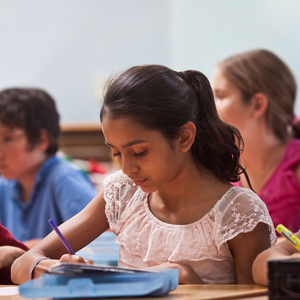 HISTORY: History tells the story of human striving and deeds, and stirs children to an experience of their own humanness. The children live through the history of ancient cultures as though they were involved in every happening. As children study the progress of humanity through many different phases of consciousness, they are led to see themselves and the age they live in as heirs of an evolutionary process they will take into the future. The study begins with the more mythical aspects and leads into the actual history. We study the development of civilization from India, Persia, Chaldea, Assyria, Babylonia and Egypt, to the Golden Age of Greece.
HISTORY: History tells the story of human striving and deeds, and stirs children to an experience of their own humanness. The children live through the history of ancient cultures as though they were involved in every happening. As children study the progress of humanity through many different phases of consciousness, they are led to see themselves and the age they live in as heirs of an evolutionary process they will take into the future. The study begins with the more mythical aspects and leads into the actual history. We study the development of civilization from India, Persia, Chaldea, Assyria, Babylonia and Egypt, to the Golden Age of Greece.
GEOGRAPHY: As the children’s horizons widen, the study of the geography of North America presents wonderful possibilities. The configuration of the regions of our country and the people and economic conditions of each region are studied and contrasted. Elements of Native American life and U.S. history are woven into these lessons to help show the connection between the human being and the part of the earth they inhabit. As the children look farther afield, they also become more independent, and individual projects are often first assigned at this age. In-depth instruction on how to do research, outlines, bibliography, write letters, take notes, and write a report is given. Each child also learns the 50 states and capital cities of the US.
LANGUAGE ARTS: The class experiences the difference between the active and passive voice of verbs, and learns to distinguish between direct and indirect speech. Much work is done with the parts of speech, verb tenses, punctuation, and the writing of different types of sentences, paragraphs, dictation, composition and poetry. Weekly spelling words are given. Daily speech exercises through recitation of poetry and tongue twisters are done. A class play is performed, often out of the history study.
ARITHMETIC: Work with common fractions and whole numbers is continued. The main work of the year centers on decimal fractions. Word problems and mental arithmetic become more complicated. Work is also done with estimating, rounding off, averages, and numbers: square, triangular, prime, perfect, and abundant. The children learn to find the area of a rectangle and square, and to figure out, for example, the price of covering a floor with a carpet.
PAINTING AND DRAWING: In painting, many themes are taken from the main lesson work with an emphasis on strength and lightness of color. Shaded drawing is done with stick crayon and pencil.
BOTANY: A phenomenological overview of plants, in general, is presented, beginning with the non-flowering plants and including evergreens and conifers as well as flowering plants, with the lily and the rose as polarities representing the monocotyledons and the dicotyledons. Students develop observation skills, notice patterns in differentiation within the individual plant, and grasp the way in which plants are grouped. The changing form of particular parts of the plant is studied in relationship to the growth of the plant upwards toward the sun. Students draw plants, observe plants in nature, and learn to write their observations succinctly.
FORM DRAWING: The drawing of complicated Celtic designs with the element of weaving is continued. The drawing of Greek shields and some Greek designs in perspective is also introduced. A few steps are taken into the realm of geometry, which will formally begin in Sixth Grade.
SPATIAL DYNAMICS: The ”Heavy/Light” or ”Wide/Thin” Bothmer Gymnastics exercise brings a strong rhythm through its dramatic quality that plays with the forces of gravity and levity. Much work is done with the Greek exercises: discus, javelin, wrestling, running and long jump. They are all done for the glory of the gods of Olympus with beauty, speed, grace and strength. Several Waldorf schools gather for the Pentathlon, a competitive display of the Greek exercises learned in Fifth Grade. Gymnastics and tumbling continue in Class Five. Each child learns to fall, tumble, and do cartwheels and handstands. Many perform in the Circus Waldissima.
HANDWORK: The Fifth Grade children return to knitting, something most of them did in First and Second Grade. They knit socks for themselves, now using four needles. With the intricate shaping of the heel (involving mathematical progressions), it is a yearlong project. This project requires a good measure of perseverance, concentration, and patience.
MAIN LESSON BLOCKS IN THE 5TH GRADE: Ancient History and Mythology from India, Persia and Egypt; Greek mythology and history; North American geography related to vegetation and agriculture; Botany; Decimals, Ratio and Proportion.
Special Subjects:
Painting: Scenes from Ancient Cultures
Spanish: Reading & Retelling of Short Stories, Basic Vocabulary
Music: Singing, Music Theory, Soprano Recorder
Handwork: Knitting Socks (with 4 needles)
Clay: Themes from Main Lessons
Instrumental Music: Violin
Farming: Animal Care, Fall Harvest
Eurythmy
Games
Skills Practice
Spatial Dynamics
6th Grade
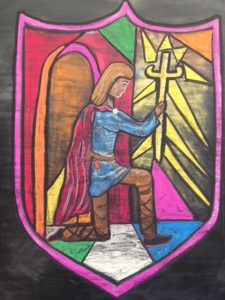 Imaginative thinking, which is characteristic of early childhood, begins to undergo a metamorphosis from which will emerge the ability to form abstract concepts. This thinking that has ripened from a healthy imagination is a “warm and mobile thinking.” Thought is imagination’s child. The ability to form abstract concepts is normally born in the late pre-adolescent period. Whereas in the Fifth Grade year, the child seemed to move with grace, lightness and agility, now movement becomes heavier, angular, and loses rhythm. The human spirit begins to penetrate the organism as far as the muscle and skeleton.
Imaginative thinking, which is characteristic of early childhood, begins to undergo a metamorphosis from which will emerge the ability to form abstract concepts. This thinking that has ripened from a healthy imagination is a “warm and mobile thinking.” Thought is imagination’s child. The ability to form abstract concepts is normally born in the late pre-adolescent period. Whereas in the Fifth Grade year, the child seemed to move with grace, lightness and agility, now movement becomes heavier, angular, and loses rhythm. The human spirit begins to penetrate the organism as far as the muscle and skeleton.
Only in Grades Six, Seven and Eight can all aspects of life and science that depend on mechanical laws be rightly presented. At this stage, when the soul-spirit being connects itself to the mechanism of the bony system and to abstraction of thought, a whole realm of new subjects and new ways of observing the world can be introduced to the class.
HISTORY: This year, there is a transition from ancient to modern history. The child is able to grasp history as a sequence of cause-and-effect relationships. Our study begins with the rise and fall of the Roman Empire. The character of this period is presented by describing the destinies of real people who helped to shaped this time. Many aspects of the Middle Ages are brought to the class through the personalities of the times.
LANGUAGE ARTS: The class reviews much of the English grammar and punctuation that was studied in previous years. The children work to develop a strong feeling for style through the use of conditional sentences and the subjunctive mood. There is much work with composition and dictation in relation to history. Weekly spelling words are given. Work is done in speech and poetry, and the class works on the long epic poems, for example, “Horatius at the Bridge,” by Lord McCauley. A class play is performed.
GEOGRAPHY: The child’s horizon is extended from our own country to Canada and Central and South America. The plant and animal life, as well as the lives of the people in each area, are studied. Map-making is done with the greatest of artistry. Research projects are often assigned.
MINERALOGY: The attributes and qualities of minerals, metals, gems and crystals are compared and explored. The characteristics and formation of igneous, metamorphic and sedimentary rocks are studied in relation to geography and plant life. Minerals’ uses to mankind are discussed. The geometrical aspects are explored. The presence of minerals such as calcium and silica in the organism of the human being is also introduced.
ASTRONOMY: A geocentric and phenomenological approach to naked eye astronomy is taken in this study of the stars. Constellations are observed, and the stories about them from various cultures are told. The ability to place oneself anywhere on the globe and to know how the night sky would appear is taught along with the phases of the moon, eclipses, the apparent movement of the stars, and the progression of the seasons.
PHYSICS: Acoustics, optics, magnetism and heat are all studied through experimentation. Powers of observation are developed; students are guided to hold back from jumping to premature conclusions. Students create lab notebooks that reflect the phenomena studied and include a description of the processes observed, the equipment used, detailed observations, and conclusions.
ARITHMETIC: The class reviews the work from previous years. They work on all aspects of percentages and its practical applications. Simple and compound interest and work with formulas are done as a preview for algebra.
GEOMETRY: Geometry develops out of the form drawing work done in Grades 1-5. How to use the tools of compass and straight edge, and also the terminology of this exciting world is begun. The class works mainly with the circle and all its divisions, but also works with finding areas and perimeters of other geometrical forms.
DRAWING AND PAINTING: Drawing with colored pencils continues, with themes brought out of the Main Lesson work. Some work is done with black and white drawing, drawing objects from life, and working with shadows. In painting, much work is done with light and dark in connection to the study of optics. Many exercises with the color wheel and complementary colors are experienced.
READING: Required book reports become more frequent. Books with historical themes and biographies are chosen for the class.
SPATIAL DYNAMICS: At the age of 12, the inner soul-life pushes through to the muscles. What was formerly done in a playful mood can now be taken up with precision and regular practice. The children learn the Bothmer Gymnastic exercise called “The Triangle.” They do rod exercises and rod fencing. They prepare for the Medieval Games by running, jousting, jumping, and throwing the javelin at a target, archery, and obstacle courses. Team sports such as basketball and volleyball are introduced, and many other games are played, including soccer, softball, and kickball. Basketball, volleyball, and cross-country teams are formed for an after-school sports league.
WOODWORK: Carving projects may include spatulas or spoons. Gouges, rasps, knives, scrapers and sandpaper are used to finish the project. Discussions focus on learning to gauge thickness, smoothness, shape, and texture; efficient and safe use of tools.
HANDWORK: The Sixth Graders are given the task of making a three-dimensional animal. This develops and requires new abilities, from drawing to imaginative picturing of how a three dimensional creation can be formed from cloth. They are working, for the first time, at looking at the parts towards the whole. There is much careful attention to detail every step of the way, including hand-sewing techniques.
MAIN LESSON BLOCKS IN THE 6TH GRADE: Roman and Medieval History; Astronomy; Geology; Physics (acoustics, optics, static electricity, magnetism); Geography extends, usually to South America; beginning Algebra; Geometry, Geometric drawing; Business Math (interest, percentage, profit/loss).
Special Subjects:
Spanish: Grammar, Latin American Poetry, Reading
Farming: Double Digging, Compost, Garden Design
Handwork: Stuffed Animal (designed & sewed by hand)
Painting: Weather, Contrasts, Geology, Moods
Circus: Juggling, Acrobatics, Mini-Trampoline
Instrumental Music: Class Orchestra (with Violin, Viola, Cello, Recorder)
Social Skills Class: Elemental Virtues, Development of Values, Social and Life Skills
Music: Singing, Music Theory, Soprano and Alto Recorder
Practical Arts: Woodwork/Carving
Skills Practice
Spatial Dynamics
Eurythmy
Sports Teams: Basketball, Volleyball, Cross-Country
7th Grade
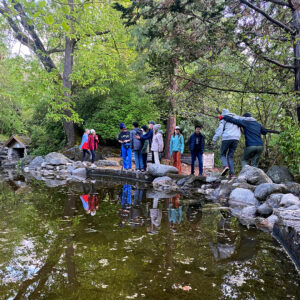 Two gestures characterize the student of Seventh Grade: an outer, active interest and curiosity, and a dynamic inner questioning. An appetite for knowledge of world phenomena mingles with a budding capacity for reflection and the first prompting of self-reflection. In this picture of emerging forces, the physical changes that accompany maturation and the capacities for conceiving new ideas and new life begin to manifest more clearly. The seventh grade curriculum themes mirror the pupils’ outer exploration of the world and their own inner journey.
Two gestures characterize the student of Seventh Grade: an outer, active interest and curiosity, and a dynamic inner questioning. An appetite for knowledge of world phenomena mingles with a budding capacity for reflection and the first prompting of self-reflection. In this picture of emerging forces, the physical changes that accompany maturation and the capacities for conceiving new ideas and new life begin to manifest more clearly. The seventh grade curriculum themes mirror the pupils’ outer exploration of the world and their own inner journey.
HISTORY: Seventh Grade history is an intensive study of the European Renaissance, the Reformation, and sea journeys that were made by explorers and conquerors. This was a major turning point in the evolution of human consciousness, for it ushered in a new age of wide scientific inquiry, exploration, and new artistic impulses, as well as exploitation and greed. Our study is done through the biography of some of the colorful dramatic figures of the times such as Joan of Arc, Michelangelo, Leonardo da Vinci, Martin Luther and several of the famous explorers.
ENGLISH: The class practices developing different forms of expression in writing through poetry and creative writing. In writing, contrasting moods such as joy/sorrow and blessing/condemnation are explored. Assignments in dictation and composition are continued, along with a weekly list of spelling words. More formalized paragraph structure is introduced. During the second half of the year, often the class works with the 2,000 most commonly misspelled words. Intense work in punctuation and grammar is done, and the class is introduced to different poetic forms. A class play is performed.
PHYSICS: The focus of these lessons is on magnetism and electricity, including their history and practical uses. The subject of mechanics includes the study of the lever and its relationship to the human arm, and continues with a study of the wheel and axle, the pulley, the inclined plane, and gravity. The approach includes experimentation and observation in order to discover laws and concepts. Biographies of important physicists are told.
CHEMISTRY: Chemistry is introduced with the study of combustion. Experiments are done in which organic and inorganic substances are subjected to burning, and the students observe this process, noting the color of the flame, the smell, and the residue of the ash. Exploration of the properties of acids and bases and the study of the limestone cycle, including firing and hydration, conclude this introduction to Chemistry.
PHYSIOLOGY: This study looks at supporting healthy nutrition, sleep, and self-image, including life processes of blood circulation, respiration, and digestion in the human being. We spend more than a week exploring human sexuality and reproduction. Reports or projects may be assigned to complement topics, including addiction, substances, media literacy, stereotyping and rites of passage.
GEOMETRIC/PERSPECTIVE DRAWING: The class works with drawing of angles, triangles, and perpendiculars. They work with formulas of area and perimeter of geometric figures and the Theorem of Pythagoras and its uses. As the children begin to experience different points of view in their own lives, they are introduced to the elements of perspective drawing. Geometric forms of the numbers 1-10 are constructed, and the qualities of each number are explored.
MATHEMATICS: The students expand their imagination in order to learn to think in new ways as they enter the realm of negative numbers. Squaring, cubing, and square roots are all worked with. The work to balance equations has a relationship to the fulcrum from our physics study and the finding of balance in oneself. Algebra helps the students formulate questions in their process of inquiry.
ART: In weekly art lessons, as well as in Main Lesson, the seventh graders draw, paint and clay-model to strengthen their developing observation skills. The students model their own hand in clay, study sketches by the great artists of the Renaissance, and try their hand in creating portraits of the Renaissance artists in pencil, watercolor and/or pastel. Main Lessons can provide themes for watercolor painting, but the wet-on- wet method is no longer the main focus of art. More freedom in illustrating Main Lesson Books and the use of calligraphy pens give the students more responsibility for beauty and detail in their Main Lesson books.
HANDWORK: The Seventh Grade learns the ancient technique of felt making. This tactile process is fun and fairly simple, relying on wool, water, soap and will power to produce a textile. As with many textiles, felt making is historically a group activity. Some students pair up and felt their partner’s slipper onto their partner’s foot. Projects are rolled into rattan blinds and pummeled with hands or feet, and special techniques are employed to shape the work. Slippers, hats, bags and balls are made and later may be embellished with embroidery.
MAIN LESSON BLOCKS IN THE 7TH GRADE: European Renaissance History (two blocks); Geography extends to Africa or Asia; Physics (electricity, magnetism, optics, mechanics); Elementary Chemistry; Human Physiology (health and nutrition, circulation, respiration, reproduction, digestion); Mathematics; Algebra; Geometry.
Special Subjects:
Spanish: Grammar, Latin American Poetry, Reading
Music: 7th & 8th Choir
Practical Arts: Textiles, Drawing, Veil Painting
Woodworking
Farming: Fall harvesting
Instrumental Music: Class Orchestra (Violin, Viola, Cello, Recorder)
Social Skills Class: Conflict Resolution, Cliques, Personal Values, Choices, Human Body
Skills Practice
Sports Teams: Basketball, Volleyball, Cross-Country
8th Grade
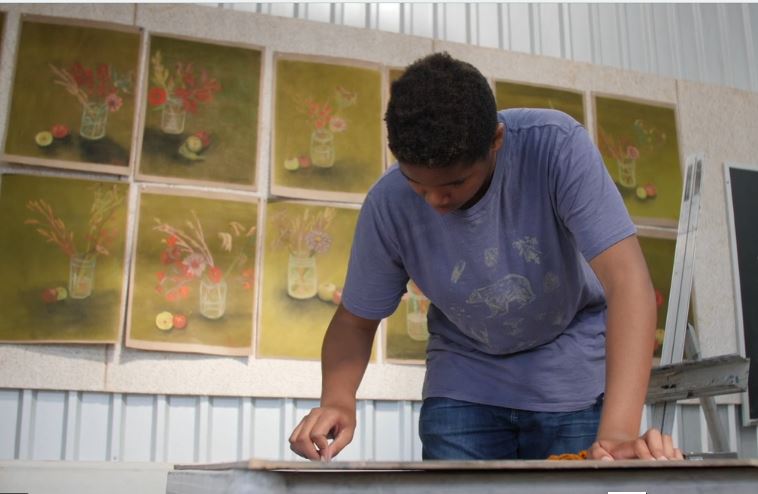 Class Eight, like the final note of the octave, comes around again to the beginning of the scale – yet transformed. The overarching theme, this year, is that students find their connection to the whole world and, through that process, come to know themselves. Students are encouraged to take greater responsibility for their learning and given the opportunity for self-discovery. Teachers strive to awaken the light of thinking as students cross the threshold from childhood to young adulthood.
Class Eight, like the final note of the octave, comes around again to the beginning of the scale – yet transformed. The overarching theme, this year, is that students find their connection to the whole world and, through that process, come to know themselves. Students are encouraged to take greater responsibility for their learning and given the opportunity for self-discovery. Teachers strive to awaken the light of thinking as students cross the threshold from childhood to young adulthood.
HISTORY: Mirroring the development of the adolescent, topics in history include studies of the American, French, and Industrial Revolutions, as well as the U. S. Civil War. Students are introduced to the development of the United States as the world’s first free democracy and travel in changing consciousness to modern times.
LANGUAGE ARTS: Working from the rich literature available to this age group, students read novels relating to main lesson work, biographies, short stories, poetry, plays, and begin work with factual writings. Writing styles and moods are examined and, in poetry, the emphasis is on dramatic and lyric styles, ballads, simile, metaphor, and the use of adjectives. We continue working with speech, recitation, and drama, which culminates in the production of the class play – sometimes taken from Shakespeare. Grammar, punctuation, parts of speech, and paragraph writing is reviewed, and essay writing introduced. Writing styles are expanded to include the formal independent research report. Public speaking and presentation is polished as each student formally shares their discoveries and artistic endeavors from a project with the school community.
MATHEMATICS AND GEOMETRY: Expanding upon the mathematics and algebra introduced in seventh grade, students are challenged in signed numbers, working in different number bases, adding, subtracting, multiplying, and dividing binomials. Solving equations, simplifying and evaluating expressions, and practical applications to algebra are practiced. Quadratic equations are brought, along with the distributive property, factoring, rules of exponents, and square roots. In geometry, students discover the theories behind the five Platonic Solids and then construct them in paper and clay. They work with three- dimensional figures to find perimeter, area, and volume.
GEOGRAPHY: Looking at the world as a whole, students find their place upon the earth through learning about the oceans, continents, and diversity of human culture. Through becoming familiar with the physical, cultural and economic aspects of the countries of Asia and Africa, in particular, students round off their geographic studies and come face to face with the challenges of the modern world.
ORGANIC CHEMISTRY: Through a phenomenological approach, students discover the qualities, origins, and chemistry of carbohydrates, proteins, and lipids (fats and oils), with a focus on their significance in human nutrition.
PHYSICS: In continuation of 6th and 7th grade studies in acoustics, optics, heat, electricity and magnetism, eighth graders work phenomenologically with hydrodynamics and aerodynamics. The subjects of electricity and magnetism are combined in the creation of electric motors.
METEOROLOGY: Global and local climate and weather is studied. Students name clouds, observe weather changes, fronts, wind, humidity, pressure, and storms in the earth’s atmosphere as they navigate their own inner mood or “internal weather.” Students review the dynamics of heating and cooling as they expand these concepts to understand the sun as the power behind earth’s climate and water cycle. Students finish the study with an understanding of the global impact of weather upon the economy and in-habitability of the continents of the world.
ANATOMY: As the adolescent senses the gravity in lengthening, hardening bones and the budding power carried to change the earth, our curriculum brings an in-depth study of the bones and muscles of the human being. The brain and nervous system are presented through the study of the eye and ear.
CLAY: After a brief review and practice of relief, the students are led into transforming a sphere into the five platonic solids. Anatomical studies are sometimes preceded by careful observations and drawings, leading to the sculpting of life-sized bones. In their arts block, students are guided in the formation of horse and rider.
BASKETRY: Eighth Graders learn the basic parts of a basket – ribs, frame, and handle – in order to skillfully and artistically make a small simple basket. They are introduced to a number of materials, both store-bought and gathered from nature, to learn to shape their basket through the weaving of these various materials. Once a basket is completed, the students can expand to different styles, shapes, forms and patterns, using more natural materials, which are harder to control.
WOODWORK: The class makes a three-legged stool. Students choose dimensions to suit the intended purpose, such as a bedside table, a chair for a young child, or a seat for an adult. The seat is cut roughly to shape, and then it is carved with a mallet and a gouge. Knowing the direction of the grain and learning to understand when grain must be cut with, against, or diagonal to the grain is explored. The mortise is cut with a drill and bit. Green logs are split to form rough billets, shaped with a chisel and hammer, refined with a draw-knife, and smoothed with a scraper and sandpaper. The tenons are cut with a special bit, split with a saw, and fitted with a wooden wedge. The parts are assembled and marked so that the position of each leg provides the greatest balance and support for the joint; the angle of each leg must support the aesthetic balance of the whole. The parts are glued, and the stool is sanded and waxed.
HANDWORK: Textiles in the Eighth Grade is the culmination of 8 years of handwork instruction begun in First Grade. It distinguishes itself from previous years by utilizing the sewing machine as an important tool. This complements their study of the Industrial Revolution in the history block. Up until this time, the students have used their own hands as their primary tools during handwork periods. In preparation for a larger project, the students learn all the features of the machine, as well as how to sew a basic straight stitch. Projects may include costumes for their own play, tote bags or pajama pants. They discover that the sewing machine is one of many useful tools, part of a more complex process drawing on many aspects of the entire handwork curriculum.
MAIN LESSON BLOCKS IN THE 8TH GRADE: Modern History; Industrial Revolution, French Revolution, American Revolution and History; Physiology (human skeleton, muscles); Physics; Algebra; Geometry (Platonic solids); Chemistry; Meteorology; Short Story or Dramatic Poetry.
Special Subjects:
Spanish: Conversation, Grammar, Latin American Poetry, Reading
Music: 7th & 8th Grade Choir
Practical Arts: Machine Sewing, Woodwork, Clay, Pastel Drawing, Watercolor Painting
Instrumental Music: Class Orchestra, Violin, Viola, Cello, Recorder
Social Skills Class: Conflict Resolution, Cliques, Personal Values, Choices, Consent, Human Body
Skills Practice
Sports Teams: Basketball, Volleyball, Cross-Country
Farm Classroom
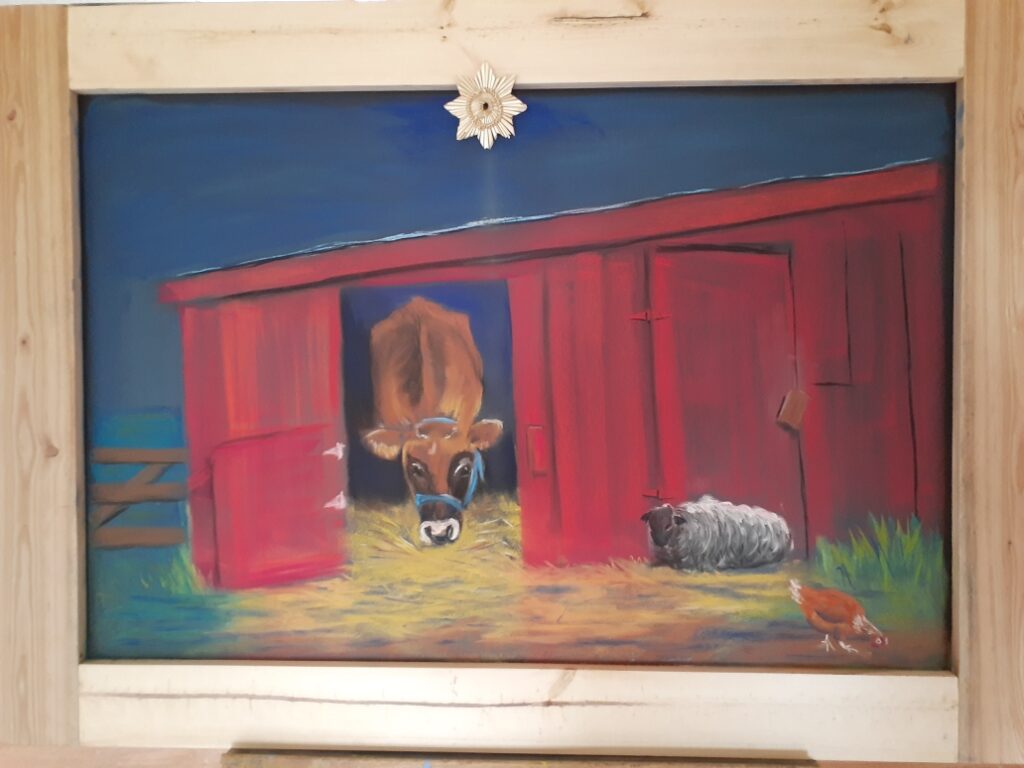 We opened the doors of Summerfield’s Farm Classroom in January 2020, a place where a small group of students of mixed ages (6-10) work, learn and grow together.
We opened the doors of Summerfield’s Farm Classroom in January 2020, a place where a small group of students of mixed ages (6-10) work, learn and grow together.
WHAT DO WE DO AT THE FARM CLASSROOM?
Fortunate to have the biodynamic farm and Summerfield’s 38-acre campus as our classroom, we start our days outside with movement, working with the rhythms of the day, the seasons and the year on the farm. We move as a group in the mornings, engaging our hands and minds in work that organically arises out of caring for the land. When we return to the classroom, we explore questions that arose out of our morning’s work.
HOW IS THE APPROACH TO LEARNING DIFFERENT?
The small group of mixed ages allows us to tailor and pace the academic and artistic work to the individual students, providing individually crafted lessons, assignments, and expectations so that each child is engaged and challenged at her/his particular level to help build confidence and skill. Through meaningful work, story-telling, writing, reading, measuring and calculating, drawing, painting, sculpting, baking bread, cutting and stacking firewood, caring for the space and for each other, the students develop a stronger stance and a deeper connection with time and space.
The Farm Classroom, based on the healing principles of Waldorf Education, aims to help students develop their will to bring to the tasks at hand to meet and overcome current and future challenges. Summerfield is welcoming students who learn differently and is excited to help them bring their unique gifts to the farm.
WHAT ARE THE HOURS?
For the younger students the day will end with lunch, whereas older students stay for afternoon classes. The Farm Class program works closely with the whole faculty at Summerfield, striving to inform and inspire each other’s work so that we can cultivate an education that meets today’s students.
WHAT IS TUITION?
Please see our Tuition & Fees Schedule
HOW DO I LEARN MORE?
Click Here to Apply. You can also contact our Admissions Director, Annalyse Jorgensen, at: (707) 575-7194 ext. 102. We look forward to meeting with you!
